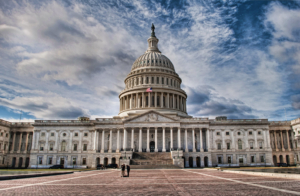Introducing the Forgoing Flights for America the Beautiful Act
by Brian Czech
The first commandment of serious policy reform is: “Thou shalt not propose sweeping legislation without the drafting thereof.” So, if we’re going to get serious about banning flights, we better produce the legislative goods. In doing so, we strive to obey the second commandment as well: “Thou shalt not propose infeasible legislation.”

“Oh Beautiful, for Spacious Skies.” Ideally with fewer contrails. (CC BY-NC 2.0, ajagendorf25)
To be feasible, the Forgoing Flights for America the Beautiful Act (FFAB) must be presented as a logical sequence of reforms. The full ban, then, is like climbing a ladder. Each step significantly reduces greenhouse gas emissions, and makes the next step more accessible and compelling. Climbing all the way to the top puts us on a rooftop of accomplishment, from which we can see clear and spacious skies, helping to make America beautiful again.
Now back on the ground where we currently stand, we have to acknowledge that the 117th Congress won’t be banning flights anytime soon. However, that doesn’t mean we should sit on our hands, staring up at the confounding contrails instead of drafting and circulating the legislation that would go a long way toward defusing an existential threat. The entire bill doesn’t have to be passed in one fell swoop, either. Stand-alone, step-wise bills could conceivably be passed by an improved iteration of Congress in the foreseeable future.
Perhaps the most important step is the first one. Let’s take it…
AN ACT
To significantly reduce greenhouse gas emissions by swiftly and substantially reducing jet-propelled air traffic.
Be it enacted by the Senate and House of Representatives of the United States of America in Congress assembled,
SECTION 1. SHORT TITLE; TABLE OF CONTENTS.
(a) SHORT TITLE.—This Act may be cited as the “Forgoing Flights for America the Beautiful Act.”
(b) TABLE OF CONTENTS.—
Sec. 1. Short title; table of contents.
Sec. 2. Findings and declarations.
Sec. 3. Definitions.
Sec. 4. Phased cessation of air transportation.
Sec. 5. Airport conversion.
Sec. 6. Enforcement and penalties.
Sec. 7. Financial relief of primary affected parties.
Sec. 8. Military air operations.
SEC. 2. FINDINGS AND DECLARATIONS.
(a) FINDINGS. Congress finds that—
(1) Climate change is a dire threat to the environment and the economy.
(2) Climate change is caused in large part by the greenhouse gas emissions resulting from human economic activities.
(3) The transportation sector is a major contributor to greenhouse gas emissions.
(4) Commercial air transportation of passengers is one of the primary sources of emissions in the transportation sector.
(5) Flights of jet aircraft are rarely essential and seldom important for the health, safety, and security of citizens.
(6) Short flights are especially inefficient, causing higher greenhouse gas emissions per unit of transportation than long flights.
(7) Alternative modes of transportation emit fewer greenhouse gases and in other ways are less responsible for climate change.
(8) Far more flights are taken in the United States than in all other nations.
(9) The severity, ubiquity, and permanence of climate change outweighs the benefits of air transportation, which tend to be short-lived and limited to a subset of the population.
(10) Other nations and the international community have taken steps to reduce air transportation for purposes of mitigating climate change.
(11) Failing to act on climate change is ultimately a threat to the Nation’s diplomatic standing and security.
(12) Reductions of greenhouse gas emissions must be swift and substantial to obviate the most catastrophic damages of climate change.
(b) DECLARATIONS. Congress declares that—
(1) It is the policy of the United States to embark upon a rapid and substantial reduction of air transportation.
(2) Air transportation services shall remain available for emergency, defense, and other national security requirements.
(3) The Department of Transportation shall assist State and regional planning authorities in shifting transportation activities from the airways to ground-based public transportation modalities, most notably passenger train and bus lines.
(4) Airports de-commissioned as a result of this Act will be restored to natural conditions or used for sustainability research purposes.
(5) An Air Industry Relief Fund shall be established for partial mitigation of financial losses from the forgoing of flights.
SEC. 3. DEFINITIONS.
In this Act—
(1) “Air transportation” means the carrying of goods or passengers in either private jets or jet-propelled aircraft operated by commercial airlines for non-military purposes.
(2) “Airline” means any incorporated firm, domestic or foreign, conducting air transportation services in the United States and its territories.
(3) “Airport authority” means an entity authorized by States and the United States to host air transportation services and related activities including flight preparations, aircraft shuttling and storage, take-offs, landings, and air traffic control.
(4) “Current” means during the twelve months prior to enactment.
(5) “Enactment” means the signing of the Forgoing Flights for America the Beautiful Act by the President.
(6) “Flight” means a single instance of air transportation comprising one take-off, one landing, and one standard route from the airport of take-off to the airport of landing.
(A) “Government flight” means a flight booked for official government civil purposes.
(B) “Long flight” means a flight of greater than two hours between takeoff and landing.
(C) “Short flight” means a flight of two hours or less between takeoff and landing.
7) “Military air operations” means all flying of aircraft by or for the Department of Defense.
8) “Private jet” means a jet-propelled aircraft owned by an individual, small business, corporation, or other non-airline entity and operated for non-military purposes.
9) “Sustainability research station” is a land unit converted from an airport and managed by the Geological Survey for studies and experiments pertaining to ecological and agricultural sustainability.
SEC. 4. PHASED CESSATION OF AIR TRANSPORTATION.
(a) AIRLINES AND AIRPORT AUTHORITIES.—
(1) An airline shall not develop, offer, or sell air transportation services to departure and arrival locations in the United States not currently served by the airline.
2) A domestic airline shall not expand its fleet of jet aircraft beyond the current number owned by the airline.
3) A domestic airline shall not expand its operation of jet aircraft beyond the current number operated by the airline.
4) An airport authority shall not expand its capacity for air transportation, flights, or airlines not currently operating at its airport(s).
5) Each airline shall perform the air transportation services currently paid for by passengers.
6) Air transportation services additional to those currently paid for may be sold by an airline only within the capacity of the airline to provide such services in accordance with paragraphs (2) and (3) this subsection.
7) The offering, sale, and operation of short flights originating or concluding in the United States shall be phased out within two years.
8) The offering, sale, and operation of long flights originating or concluding in the United States shall be phased out within four years.
9) Each airline shall develop a Forgoing Flights Plan that must be submitted to the Federal Aviation Administration for approval within six months of enactment, and distributed to shareholders within 12 months of enactment, and which shall include:
(A) a summary of this Act as provided by the Federal Aviation Administration.
(B) a schedule for phasing out short flights, specifying last dates of service to specific airports.
(C) a schedule for phasing out long flights, specifying last dates of service to specific airports.
(b) PRIVATE JETS.—
1) The manufacture of private jets in the United States or by domestic firms operating overseas is prohibited, effective immediately, except that the manufacture of partly assembled private jets may be completed for a period of six months following enactment.
2) The sale of private jets shall be prohibited beginning one year after enactment.
3) A private jet may log no more than 20,000 miles during the first year after enactment, no more than 10,000 miles during the second year after enactment, and no more than 5,000 miles during the third year after enactment.
4) Private jet flights shall be prohibited after three years following enactment.
c) PASSENGERS.—
1) Each passenger is prohibited from taking more than 24 flights during the first year after enactment, with the exception of passengers who had more than 24 flights purchased prior to enactment, who are prohibited instead from purchasing additional flights in said year.
2) Each passenger is prohibited from taking more than twelve flights during the second year after enactment.
3) Each passenger is prohibited from taking more than six flights during the third and fourth years after enactment.
4) Beginning four years following enactment, individuals are prohibited from booking or purchasing air transportation services.
(d) GOVERNMENT FLIGHTS.—
1) Government flights are hereby prohibited with the following exceptions:
(A) Emergency flights.
(B) Flights currently booked.
(C) Flights deemed essential to the mission of the agency.
(2) Except for emergency flights and flights currently booked, a government flight must first be approved by the director or administrator of the agency.
(e) FLIGHTS WITH ONE ENDPOINT.—
In addition to flight restrictions described elsewhere in this Act, flights that land at the airport of departure are strictly prohibited.
SEC. 5. AIRPORT CONVERSION.
(a) CONVERSION OPTIONS.—
(1) Following the cessation of private and civil jet aircraft operations pursuant to Section 4 of this Act, each airport shall be converted into one of the following:
(A) State park, managed by the park authority of the State with jurisdiction.
(B) Wildlife refuge, managed by the State agency with wildlife management jurisdiction in collaboration with the Fish and Wildlife Service, in the latter case for purposes of migratory species management, threatened and endangered species conservation, anadromous fisheries management, marine mammal conservation, or a combination of those activities coming under Federal wildlife jurisdiction.
(C) Sustainability Experiment Station, managed by the Geological Survey in collaboration with the Agricultural Research Service.
(D) Aircraft Experiment Station, managed by the Federal Aviation Administration in collaboration with the National Oceanic and Atmospheric Administration.
(2) Conversion options for an airport shall be studied and compared by the airport authority, in consultation with local and regional representatives of the agencies identified in subsection (a), paragraph (1) of this section.
(3) Within two years of enactment, each airport authority will deliver to the relevant Governor and State legislature a Report of Airport Conversion Options, which shall include a recommendation for a preferred conversion option, with second and third options also identified.
(4) In consultation with Statehouse leadership, the relevant Governor will decide which conversion option to select.
(b) AIRPORT CONVERSION PLAN.—
(1) The airport conversion option selected by the Governor shall be developed by the corresponding authority: that is, State park authority, State wildlife management authority, Geological Survey, or Federal Aviation Administration, as identified in subsection (a), paragraph (1) of this section, and in collaboration with other parties identified therein as appropriate.
(2) Within three and a half years of enactment, the corresponding authority as described in paragraph (1) of this subsection shall deliver a draft Airport Conversion Plan to the Governor.
(3) At a minimum, a draft Airport Conversion Plan shall include:
(A) The name of the new land unit (park, refuge, etc.).
(B) The mission of the new unit.
(C) Identification of official leadership.
(D) Management goals and objectives for the unit.
(E) Description of management practices.
(F) A five-year budget estimate with line items.
(G) Realty procedures for appropriate title-holding.
(4) Within three months after receiving a draft Airport Conversion Plan from a proper authority, the Governor shall either adopt the plan or edit it in consultation with the proper authority and other key stakeholders.
(5) No later than four years after enactment, the Governor will release and publicize the final Airport Conversion Plan.
(c) CONVERSION OF AIRPORT.—
(1) Airport conversion pursuant to a final Airport Conversion Plan shall commence immediately following the fourth year after enactment.
(2) Entrance and boundary signs shall be posted during the first month of conversion, identifying the new land unit for the public.
(3) Runways, hangars and other airport infrastructure may either be proactively removed or passively left to the forces of nature, depending upon the mission and goals of the unit as well as available funding.
(4) Each sustainability experiment station shall be managed in accordance with a Sustainability Experiment Station Plan, to be prepared by the Geological Survey and approved by its Director within two years of airport de-commissioning. The Sustainability Experiment Station Plan will be updated by the Director every five years.
(d) SUSTAINABILITY EXPERIMENT STATIONS.—
(1) A sustainability experiment station is a land unit converted from an airport and managed by the Geological Survey for the purpose of studying the sustainability of ecosystems and the feasibility of land management practices to assist with ecological and economic sustainability.
(2) A sustainability experiment station may be used for studies and experiments pertaining to forestry, wildlife and fisheries, range management, hydrology, fire, weather and climate, carbon sequestration, phenology, pollination, organic crop production, and other ecological, agricultural, and natural resource issues.
(3) Sustainability experiment stations concerned with agricultural practices may operate with substantial input from and collaboration with the Agriculture Research Service.
(e) AIRCRAFT EXPERIMENT STATIONS.—
(1) An aircraft experiment station is a land unit converted from an airport and managed by the Federal Aviation Administration for the purpose of studying and developing more sustainable flight operations, airport infrastructure, and aircraft, especially aircraft that emit less greenhouse gases than current jet aircraft.
(2) Each aircraft experiment station will host offices or laboratories of the National Oceanic and Atmospheric Administration, scientists from which will assist with and in some cases oversee experimental design, research, and statistical analysis.
(3) Each aircraft experiment station shall be managed in accordance with an Aircraft Experiment Station Plan, to be prepared by the Federal Aviation Administration and approved by its Administrator within three years of airport de-commissioning. The Aircraft Experiment Station Plan will be updated by the Administrator every five years.
SEC. 6. VIOLATIONS, ENFORCEMENT, AND PENALTIES.
(a) AIRLINES AND AIRPORTS.—
(1) Airlines in violation of section (4), subsection (b) of this Act will be subject to criminal penalties of up to one million dollars ($1,000,000) per offense and sentences of up to two years in prison as imposed and prosecuted, respectively, by the Federal Aviation Administration.
(2) Airport authorities in violation of section (4), subsection (b), paragraph (4) of this Act will be subject to criminal penalties of up to five hundred thousand dollars ($500,000) per offense and sentences of up to one year in prison as imposed and prosecuted, respectively, by the Federal Aviation Administration.
(b) PRIVATE JETS.—
(1) Manufacturers and sellers of private jets in violation of section (4), subsection (b) of this Act will be subject to criminal penalties of up to two hundred thousand dollars ($200,000) per offense and sentences of up to two years in as imposed and prosecuted, respectively, by the Federal Aviation Administration.
(2) Private jet owners and operators in violation of section (4), subsection (b) of this Act will be subject to civil penalties of up to fifty thousand dollars ($50,000) per offense as imposed by the Transportation Security Administration.
(c) PASSENGERS.—
(1) Passengers in violation of section (4), subsection (c) of this Act will be subject to civil penalties of up to fifteen thousand dollars ($15,000) per offense as imposed by the Transportation Security Administration.
SEC. 7. FINANCIAL RELIEF OF PRIMARY AFFECTED PARTIES.
(a) ESTABLISHMENT OF RELIEF FUND.—
(1) An Air Industry Relief Fund is hereby established for purposes of delivering limited financial relief to certain parties affected by this Act.
(2) The Relief Fund shall comprise a re-appropriation of the Airport and Airway Trust Fund, which shall be dissolved upon said re-appropriation.
(3) The Relief Fund shall be held by the Treasury.
(4) Relief Fund distributions shall be managed by the Federal Aviation Administration’s Deputy Administrator for Financial Services, who shall upon enactment:
(A) Develop an application process for Relief Fund distributions, including application instructions consistent with but additional to subsection (b), paragraph (3) of this section.
(B) Distribute application instructions to the eligible parties identified in subsection (b), paragraph (1) of this section.
(C) Publish the application instructions in the Federal Register within 18 months of enactment.
(5) Relief Fund distributions shall not be used for employee or executive bonuses or other benefits beyond salaries and wages.
(6) The duration of the Relief Fund shall be ten years, commencing two years after enactment.
(b) ELIGIBILITY OF AFFECTED PARTIES.—
(1) Affected parties eligible for Relief Fund distributions shall include:
(A) Airlines
(B) Airports
(C) Airline employees
(D) Private jet owners
(2) Affected parties currently in bankruptcy proceedings are not eligible for Relief Fund distributions.
(3) An affected airline or airport may apply for Relief Fund distributions to the Federal Aviation Administration consistent with instructions and with a detailed description of:
(A) Financial position including:
(i) Assets and income
(ii) Debts and obligations
(iii) Shareholder equity
(B) Financial effects of this Act including:
(i) Loss of revenue
(ii) Devaluation of fixed capital
(iii) Interest payments on unmet obligations
(iv) Penalties assessed due to unmet obligations
(4) An affected employee may apply for Relief Fund distributions to the Federal Aviation Administration, consistent with instructions and with a detailed description of:
(A) The period of time the employee has been financially affected by this Act.
(B) Salary and wages received by the airline or airport for the five years preceding enactment.
(C) Salary and wages, from any sources, during the period of time the employee has been affected by this Act.
(5) A private jet owner may apply for Relief Fund distributions to the Federal Aviation Administration, consistent with instructions and with a detailed description of the devaluation of the private jet or jets owned, subject to the following limitations:
(A) A maximum of one private jet may be considered for purposes of Relief Fund distributions.
(B) A maximum of one half the devaluation of a jet identified pursuant to subparagraph (A) of this paragraph may be distributed from the Relief Fund.
(c) BANKRUPTCY.–
(1) An airline or airport unable to meet its financial obligations may file for bankruptcy pursuant to Chapter 7 or Chapter 11 of the Bankruptcy Code.
(2) Proceeds from the liquidation of assets shall be distributed among shareholders.
(3) During bankruptcy proceedings, any Relief Fund distributions successfully requested by an airline or airport shall be distributed in the following order until exhausted:
(A) Airline or airport employees, not including executive officers, to whom salaries and wages are owed.
(B) Municipalities to which rents, taxes, and fees are owed.
(C) Creditors to whom interest is owed.
(D) Executive officers to whom salaries are owed, at salary levels no higher than at the time of enactment.
SEC. 8. MILITARY AIR OPERATIONS.
Within two years of enactment, the Secretary of Defense shall submit to Congress a plan to lower greenhouse gas emissions from military air operations by at least fifty percent (50%).








Excellent. – unfortunately like everything else related to global warming, popular support won’t come until the effects are obvious. October, however will provide a chance for discussion – Here’s a timeline from the stars: https://gfbegjiazgzkmhiq.quora.com/A-follow-on-from-Managing-the-Ego-Neil-Crabtrees-post-in-Neil-Crabtree-https-gfbegjiazgzkmhiq-quora-com-Managing
While not doubting for a minute the effects of flying on the accumulation of greenhouse gases, Foregoing Flights will immediately add massive amounts of automobile miles and emissions to the greenhouse gas problem. There are no viable mass transportation alternatives to air travel in the United States, unfortunately. Even in the Northeast where there are undoubtedly excessive short flights between closely spaced cities, banning flights will be resisted stoutly. The area has the fastest rail service in the US today, but Amtrak between New York and Washington takes three and a half hours; from Philadelphia to Pittsburgh takes 9 hours; NY to Boston takes 3 1/2 to five hours. I’ve taken the Sunset Limited twice between Tallahassee and the West Coast, a trip that took three days, much of it crawling at 15 to 20 mph behind interminable Union Pacific freight trains. Buses are more comfortable than they used to be, with more amenities, but with extended families as common as they are today, good luck trying to tell them they have to spend days and days traveling to see each other.
You goal of phasing out the short flights is not wrong but rail transport will have to be much improved first. This is not impossible: the Acela runs at around 125 mph and trains between Chicago and Minneapolis used to regularly run at 100mph. Under steam. If the entire Northeast rail system was upgraded to ‘Acela Corridor’ standards, they would probably be sufficient political cover to drastically cut back short flights.
The outlook for long distance transportation is much bleaker. There could be some substantial improvements in train schedules but that will involve taking back trackage rights from the railroad companies (which go those rights free from the government in the first place). Economist Michael Hudson warns that we’ll never see the high speed rail systems like they have in China because the real estate speculators have so inflated land prices that corridors could never be bought.
ONe th9ng to consider is airship, helium filled dirigibles powered by small electric motors. Can go downtown to downtown as they do not need large runways, and the motors could run on solar power (batteries) Not as fast as jets, but can be faster than cars
Good work on drafting the legislation but I would suggest a modification by referring only to those aircraft powered by fossil fuels. This would be similar to existing plans to phase out the sale and use of automobiles powered by fossil fuels. The introductory statement to the proposed act could be as follows:
“AN ACT
To significantly reduce greenhouse gas emissions by swiftly and substantially reducing jet-propelled air traffic that is powered by fossil fuels.”
Here is an excerpt from the Airbus website on the future use of green hydrogen to power aircraft at: https://www.airbus.com/newsroom/stories/hydrogen-aviation-understanding-challenges-to-widespread-adoption.html:
“This 2030 timeline is in line with Airbus’ anticipated delivery of its ZEROe programme. Indeed, according to Glenn Llewellyn, VP of Zero-Emission Aircraft, Airbus is targeting the use of green hydrogen to fuel its future zero-emission aircraft. He believes declining costs for renewable energy and the scaling up of hydrogen production could make green hydrogen increasingly cost-competitive with existing options, such as jet fuel and sustainable aviation fuels.”